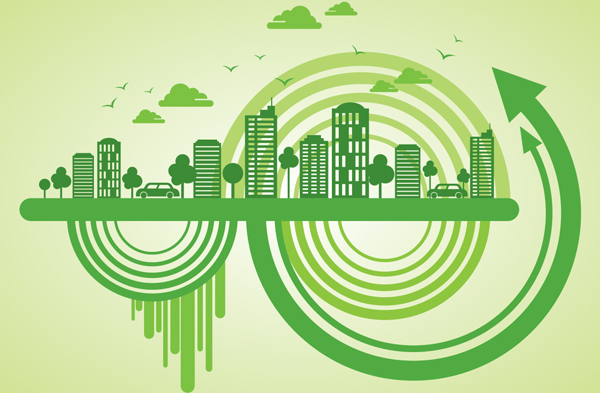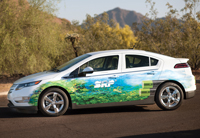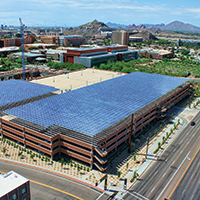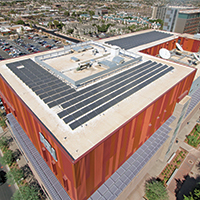 Green is good, we all agree. That is, it’s better as a business to be more resource efficient, less polluting, and generally more thoughtful about our impact on the environment. But how much is all this green goodwill really accomplishing when it comes to protecting our environment, combating global warming and, yes, producing profits?
Green is good, we all agree. That is, it’s better as a business to be more resource efficient, less polluting, and generally more thoughtful about our impact on the environment. But how much is all this green goodwill really accomplishing when it comes to protecting our environment, combating global warming and, yes, producing profits?
The Phoenix Suns have been fairly good corporate citizens. In recent years, the Suns replaced all office and parking garage lighting with energy-efficient lighting, and they installed a 966-panel solar structure, which produces roughly 378,000 kilowatt-hours per year. This is enough energy to power 20 Suns home games each season. That’s great, but as basketball fans know, this is only about half the home games.
Yet even this limited gesture toward sustainability was a challenge to pull off. The Phoenix Suns’ senior vice president and general manager of Sports & Entertainment Services & Ticket Operations, Ralph Marchetta, says, “When we first started looking at becoming more sustainable, we were overwhelmed at the costs involved, so we said, ‘Let’s do what we can, when we can.’”

Salt River Project maintains a fleet of electric cars for its employees. Photo courtesy of Salt River Project
It’s perfectly good advice for business but may be bad news for the environment, and therein lies the dilemma. How can business be true to its bottom line, and aggressively combat climate change and the further degradation of our environment?
“Right now it’s a want to, rather than a need to,” says Reynold Byers, who teaches in the Supply Chain Management Department at the W. P. Carey School of Business at ASU, “so there’s a lot of wheel-spinning that goes on. Companies create their corporate social responsibility office and send out memos and reports, and it’s all very symbolic.”
In the last decade, the best thing that happened to our world environmentally was also the worse thing economically — the Great Recession. The resulting slump in manufacturing reduced the growth in damaging carbon emission. But in the long term, the recession also blocked any political progress that might have been made on related issues, including major investment in alternative energies and major legislation to curtail climate-changing activities.
Obviously, recession is no long-term fix for our environment, and, as economic indicators generally trend upward, so too does the generation of carbon emissions and other toxic threats. If goodwill gestures are symbolically significant but practically insufficient, then clearly the real answer lies at the intersection of growth and sustainability. “When you turn sustainability into a market opportunity, that changes the conversation,” says Byers.

One of several solar installations at Arizona State University, on Universtiy Dr. and Rural Rd. © 2013 Arizona Board of Regents on behalf of Arizona State University. Used with permission.
Recycling, Obsolescence and Opportunity
An example of sustainability as a business driver is the move by Avnet, the electronics distributor, into device refurbishment and recycling. Since November 2011, Avnet has acquired five companies that provide lifecycle services, such as recycling, repair and refurbishment in both the U.S. and internationally.
Traditionally, Avnet has been primarily concerned with initiating the product lifecycle — that is, selling goods to end-users. But recently, it has changed its strategy to account for the entire life cycle, including sales, support and recycling, according to Tony Vottima, senior vice president and general manager of Avnet Services in the Americas.
“There is money in recycling,” says Vottima, “but there are also other business opportunities that come with it. Recycling expands Avnet’s customer base, into areas like cable and telecom. We also have the opportunity to backfill with new equipment rounding out the supply chain.”
Its customers have traditionally included major OEMs (original equipment manufacturers) who lease products and then take them back, as well as the end-users who purchase products outright. By servicing the end of the product lifecycle through recycling, Avnet positions itself to sell new product and start the cycle all over again.
“This is the holy grail of the supply chain — closing the loop on the product lifecycle,” says Byers, “but it takes resources to do it.”
There are several revenue channels within the Avnet Refurbishment Program. Some devices are repaired for resale to customers who don’t require state-of-the-art equipment. Further revenue is gained through the resale of parts that retain some market value, such as disc drives. Other materials are melted or otherwise broken down for sale as scrap.
In all, the Avnet Refurbishment Program has kept approximately 252,000 pounds, or 126 tons, of electronic waste from entering landfills over the past three years. One of the main Avnet facilities involved in this program is Avnet Global Solutions Center, in Chandler.
Two trends make the timing for Avnet’s expansion in recycling particularly compelling, according to Vottima. The first is the increased rate of obsolescence in electronics. Yesterday’s gadget is becoming today’s garbage more rapidly than ever before. The second factor is cloud computing, which is enabling companies to shrink or eliminate data centers, leaving a lot of excess gear “sitting around taking up space.”
Says Vottima, “The opportunity is growing, and the fact that Avnet can scale will help accelerate it.” Another way to put it is, when the big boys play, that’s when the game changes.

One of several solar installations at Arizona State University, at Walter Cronkite School in Downtown Phoenix. © 2013 Arizona Board of Regents on behalf of Arizona State University. Used with permission.
Small Business Sustainability Models
Small businesses are building models around sustainability as well. Clean Air Cab is a Phoenix company with a 100-percent hybrid fleet of 52 Toyota Prius cars. Four years ago, Steve Lopez and his wife, Ginger, were considering a range of sustainability-based businesses, from manufacturing to travel. They were open to many ideas as long as the model was driven by sustainability at its core.
At the time, Steve was studying to become a pilot, but previously had raced cars professionally and always felt comfortable around automobiles, which influenced their decision. They started Clean Air Cab with 10 cars four years ago. The business advantage was clear. The Prius requires half the fuel of a conventional automobile. Clean Air Cab’s drivers are independent contractors, and they pay for their lease and their gas. Paying half for their gas makes them want to drive for Clean Air Cab. At the moment, 102 are choosing to do so. “I’m gaining all the way around,” says Lopez. “The only sacrifice is the size of the car. Other companies can offer bigger cars, but other than that I’m way ahead.”
Lopez also believes he is getting a boost from the marketplace for being a sustainable business, from riders who would rather go green as well, but can only guess at how much. “It’s certainly not hurting us any,” he says.
Clean Air Cab employs a Toyota-certified technician whose job is to keep the hybrids running at optimum performance. This is expected to considerably extend their road life, to 500,000 miles and as high as 700,000 miles. These numbers sound improbably high to a novice, but the fleet is at 300,000 miles now and going strong. Simply keeping these hybrids on the road that long is a form of recycling itself, insofar as the cars provide much more service before they will need to be junked and replaced.
Not-for-Profits Profiting Through Sustainability
Not-for-profits are leveraging sustainability as a key driver as well. Arizona State University is a case in point. The school already boasts the largest solar array of any university in the country, according to Associate Vice President of University Business Services and Sustainability Operations Officer John Riley, generating 22.4 megawatts of power, or 30 percent of the university’s total daytime demands. ASU has also installed a natural gas heat and power plant on campus, possesses 36 LEED Certified buildings and has extensive recycling programs in place.
One could argue that this is simply good citizenship being practiced by a major public institution, but, in fact, it’s also good business. Many key constituencies of ASU care deeply about sustainability, including students, faculty and upper management. “The support is both top down and bottom up,” says Riley, noting that is a key to successfully deploying such programs.
According to Riley, there are now 147 degree-granting programs in sustainability nationwide, so the field is a competitive one. By becoming a model of sustainability itself, ASU positions itself at the front of the pack, supporting its own School of Sustainability, the Global Institute of Sustainability and the Walton Sustainability Solutions Initiatives. In effect, being a leader in solar power and other sustainability policies is a significant asset of the University’s brand.
Seen in this light, ASU’s aggressive goal of being carbon neutral by 2035 is also a well-reasoned strategy from which the University can expect to gain significantly. To achieve its goal would require eliminating or offsetting emissions of 420,000 metric tons of carbon dioxide annually, which it currently produces. The target is so ambitious, as Riley, points out, “many of the technologies we will need to do this haven’t even been invented yet.” But for ASU, which also touts itself as a major research university, it makes sense to bet on innovation. It may generate some of the solutions in-house as well as serving as an early adopter of solutions developed elsewhere, further enhancing its standing as an innovator.
An interesting twist on nonprofits leveraging sustainability for growth is Cox Charities, the charitable arm of Cox Communications, which raises money through its internal sustainability program. Cox Arizona provides employees with convenient recycling options, to divert waste from landfills and reduce waste disposal costs. All recycling revenue directly benefits Cox Charities. This double dose of do-gooding has helped support organizations like American Red Cross, Phoenix Theater and Teen Addiction Anonymous, while, of course, contributing to a slightly greener world.
The Energy to Do Better
While it’s in the interest of every organization large and small to help address climate change and environmental protection, clearly some are expected to do more than others. Among these are energy companies, like SRP, whose product lies at the heart of the matter. Burning fossil fuels is a leading contributor to carbon dioxide emissions and, therefore, to global warming.
SRP is working toward a goal of relying on 20 percent renewable energy by 2020, according to John Hetrick, manager of Sustainability Policies and Programs. To that end, it is developing hydro, geothermal, wind, solar and landfill gas alternatives. Hetrick says they “all are promising, and directly contributing to our goal.” Still, it remains to be seen which of these will prove to be practical replacements for the carbon-emitting coal, which many of its plants burn.
Another way to contribute to this goal is simply to become more energy efficient in general, in order to consume less in the way of non-renewable energy. SRP offers rebates and discounts to consumers who take steps to improve efficiency and is increasing education to customers about water management. At the same time, SRP is now engaging employees more intensively, too. This includes preferred parking for car-poolers, bus passes to encourage the use of public transportation, and bicycles employees can ride between buildings.
SRP also maintains a fleet of electric cars. These reduce emissions, of course, but they also serve as a kind of controlled experiment to “help us better understand how electric cars fit in to a business, what infrastructure they require to be effective,” says Hetrick.
SRP invites employees to drive the e-cars simply to get more comfortable with them. To date, about 200 employees have taken the company up on the offer. Clearly a number that won’t change the world any time soon,
but it’s a start in educating people about this alternative.
Big Answers for a Growing Problem
If one considers that global warming is on the increase and consumer behavior is trending toward being more wasteful, not less so, then the claim of “making a difference” in regard to the environment requires increasingly ambitious goals to match. This is the view of Henkel, the international consumer products giant whose North American headquarters is based in Scottsdale, according to its Senior Research Fellow for Sustainability, Pete He. He says Henkel’s new strategy is to improve its environmental efficiency by a factor of three by 2030. “We want to triple the value we create for the footprint made by our operations, products and services,” he says.
The only way to achieve this, He observes, is to make sustainability a business driver.
One benchmark is to increase sales 10 percent net sale per production unit by 2015 through sustainability. “Using less to deliver more is good for consumers and the environment,” says He, “and eventually it should be good for business.”
As the use of “eventually” implies, patience is a key component of this strategy. That’s because within the lifecycle of consumer products, the single greatest factor in sustainability, according to He, isn’t how they are manufactured, or even how they are disposed of; it’s how consumers use them. For example, if users of Dial hand wash would simply lather their hands with the product before turning on the water, they would save millions of gallons on an on-going basis.
Similarly, Henkel’s Purex brand of detergent is already advanced enough to work in room temperature water, but most consumers don’t believe that. If they would simply turn their temperature knob to cold water, the environmental implications would be massive. So Henkel is seeking to partner with stores and appliance makers to change the perception that cold means not clean. This would help increase sales while saving a lot of energy.
“Sometimes it takes a village to move the mountain,” says He.
Henkel is also marketing products that offer greater green benefits. Henkel introduced a green bottle version of Purex (normally sold in a blue bottle), which is 95-percent naturally sourced using biodegradable ingredients, twice as concentrated requiring 53 percent less packaging, and includes no unnecessary dyes. He says it is the leader in its segment. “We have a long way to go, but we are encouraged.”
But Henkel, like any company, can go only so far within its own supply chain. Ultimately, it is industry-wide change that will deliver the greatest real environmental impact.
Environmentally friendly industry norms are required to enable major manufacturers to follow more sustainable practices without paying a price in the marketplace.
Henkel is a founding member of the Sustainability Consortium, whose members include more than 100 of the largest consumer manufacturers from around the world. They are working on building consensus for science-based sustainability best practices for each category of retail product. One critical issue they are addressing is over-packaging, in order to minimize resources expended on packaging without hurting the shelf performance of any one particular brand.
The Sustainability Consortium developed the Walmart Sustainability Index, which provides members like Coke, General Mills, Unilever and others a framework within which to assess and rank the sustainability performance of their supply chains.
When the big boys play together, the game can change even more. It could lead to businesses establishing standards for sustainability that transform industries, rather than simply polishing their own public images. Especially if they can make money while they are at it.














Speak Your Mind
You must be logged in to post a comment.